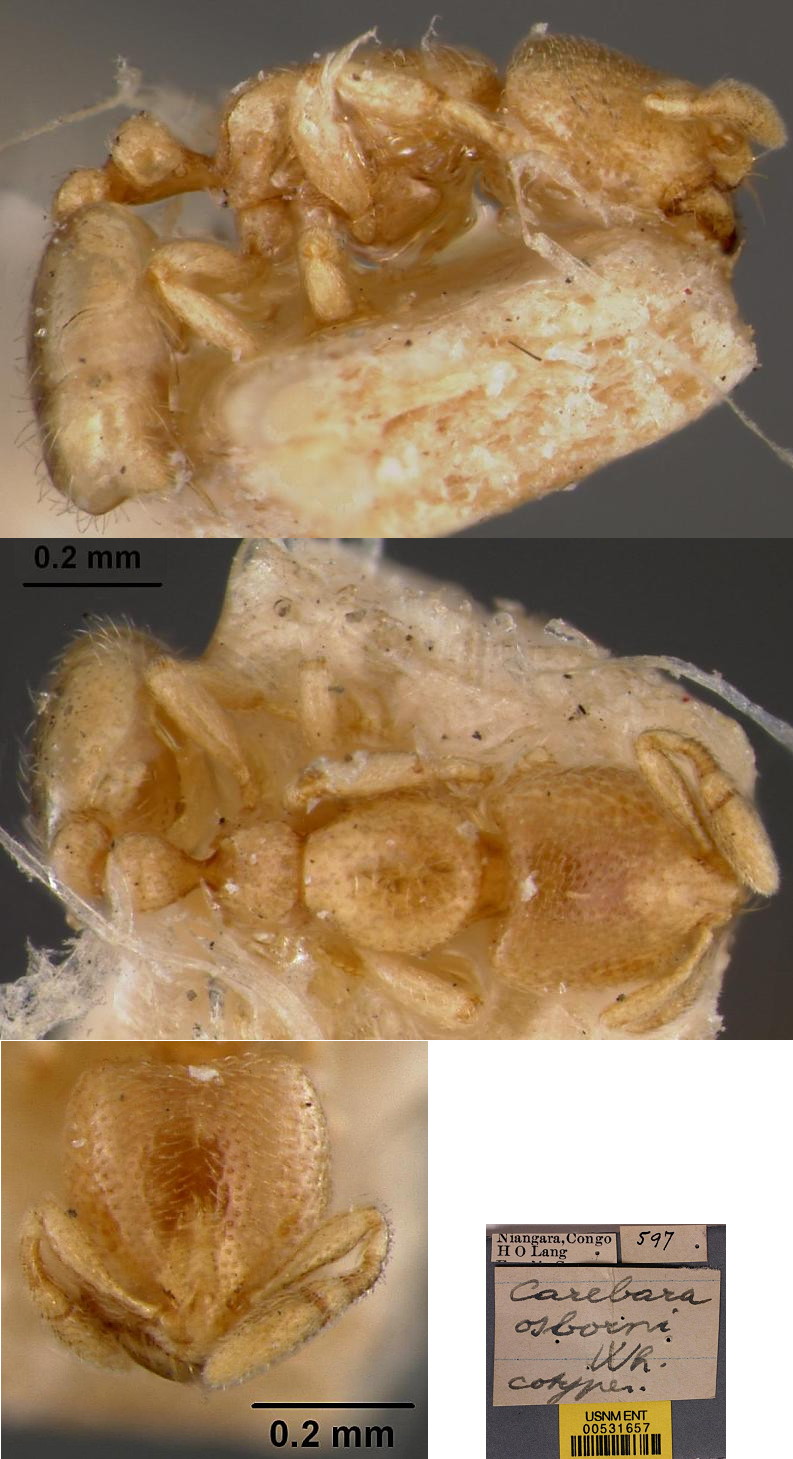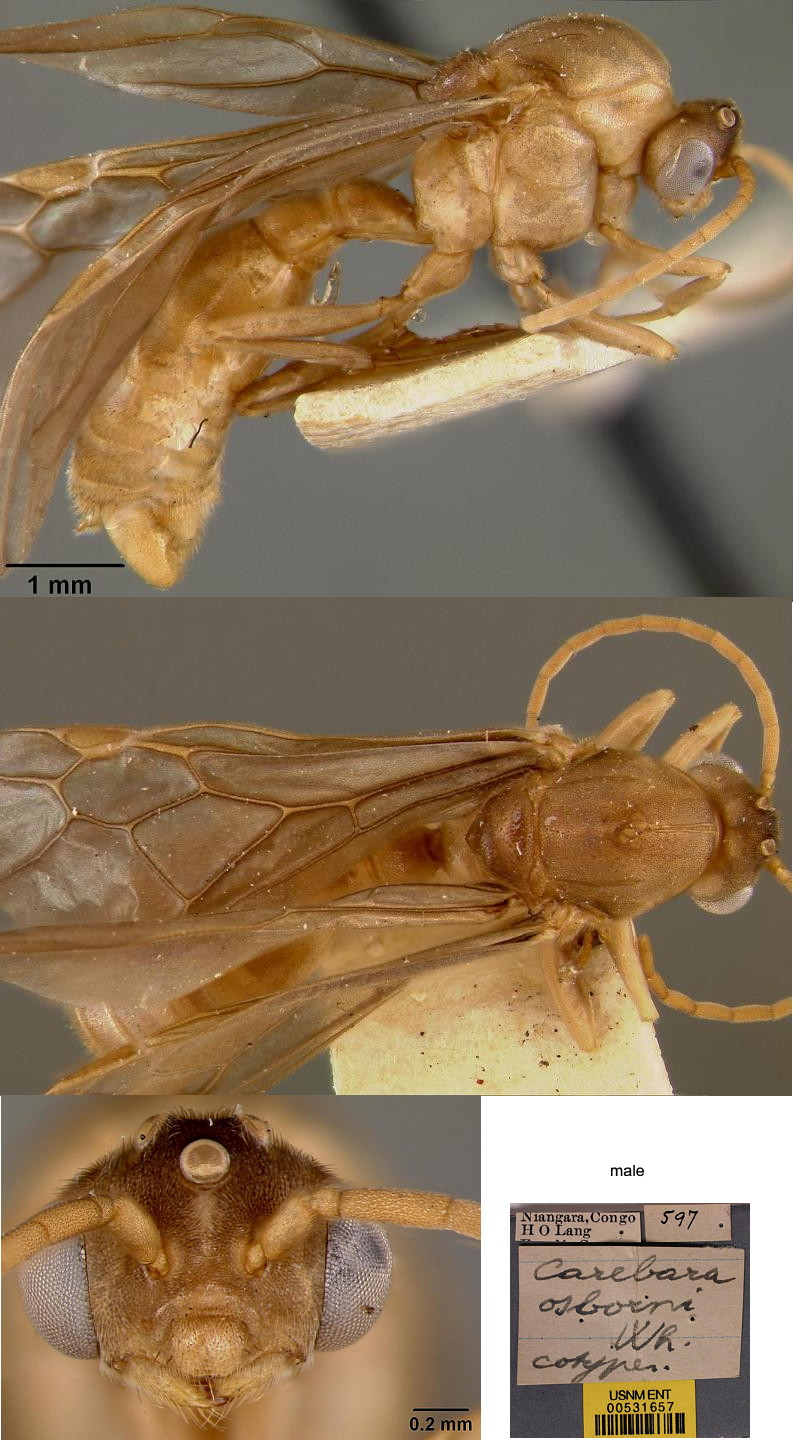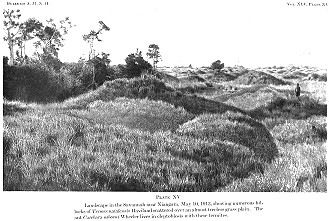Carebara osborni Wheeler
 queen - queen - 
 Type location Zaïre
(Wheeler, 1922: 174, illustrated, all forms); all forms known (see
Bolton, 1995) Type location Zaïre
(Wheeler, 1922: 174, illustrated, all forms); all forms known (see
Bolton, 1995)  . .
|
 Wheeler's
(1922) illustration of the worker, male and
queen is right. Wheeler's
(1922) illustration of the worker, male and
queen is right.
Described by Wheeler (edited for modern terminology)
|
 WORKER - length 0.8 to 1 mm. Head subrectangular,
slightly longer than broad, as broad in front as behind, with nearly
straight posterior and very feebly and evenly rounded lateral borders.
Eyes absent. Mandibles convex, with oblique 4-toothcd apical borders.
Antenna 9-jointed, the scapes reaching to the middle of the sides of
the head; funiculus joints 2 to 6 very small, slightly broader than
long (too long in the figure), terminal joint longer than the remainder
of the funiculus (too short in the figure). Alitrunk narrower than the
head; pro- and mesonotum flattened above, suboctagonal, a little longer
than broad; propodeum subcuboidal, of the same height as the
promesonotum but narrower, as long as broad, the base and declivity
subequal in profile, meeting at a right angle, the base not marginate
on the sides, the declivity in the middle sloping and longer than the
base. Metanotal suture very distinct but not impressed. Petiole node as
long as broad, subglobular, pedicel short; postpetiole not broader than
the petiole, with much smaller node. Gaster and legs of the usual
shape. Shining; mandibles finely and sparsely punctate; head and
Alitrunk above coarsely punctate, the latter more sparsely; punctures
on the remainder of the body finer and sparser. Hairs pale yellow,
short, subappressed, not very abundant, most distinct on the gaster.
Pale brownish yellow, mandibular teeth and anterior border of clypeus
darker brown.
WORKER - length 0.8 to 1 mm. Head subrectangular,
slightly longer than broad, as broad in front as behind, with nearly
straight posterior and very feebly and evenly rounded lateral borders.
Eyes absent. Mandibles convex, with oblique 4-toothcd apical borders.
Antenna 9-jointed, the scapes reaching to the middle of the sides of
the head; funiculus joints 2 to 6 very small, slightly broader than
long (too long in the figure), terminal joint longer than the remainder
of the funiculus (too short in the figure). Alitrunk narrower than the
head; pro- and mesonotum flattened above, suboctagonal, a little longer
than broad; propodeum subcuboidal, of the same height as the
promesonotum but narrower, as long as broad, the base and declivity
subequal in profile, meeting at a right angle, the base not marginate
on the sides, the declivity in the middle sloping and longer than the
base. Metanotal suture very distinct but not impressed. Petiole node as
long as broad, subglobular, pedicel short; postpetiole not broader than
the petiole, with much smaller node. Gaster and legs of the usual
shape. Shining; mandibles finely and sparsely punctate; head and
Alitrunk above coarsely punctate, the latter more sparsely; punctures
on the remainder of the body finer and sparser. Hairs pale yellow,
short, subappressed, not very abundant, most distinct on the gaster.
Pale brownish yellow, mandibular teeth and anterior border of clypeus
darker brown.
The photomontages are collated from The Smithsonian
Insitute cotype images at http://ripley.si.edu/ent/nmnhtypedb/public/specimeninfopage.cfm?publicconsumption=1&typespecimenID=676
|
FEMALE (dealated) - length 8 mm. Head, including
the mandibles, as long as broad, broader behind than in front, with
feebly convex posterior border, rounded posterior corners and straight
cheeks. Eyes not very convex, on the sides of the head. Ocelli large,
in deep impressions. Mandibles large, with oblique, 4-toothed apical
borders. Clypeus with a broad longitudinal median impression, its
anterior border broadly and sinuately emarginate in the middle. Frontal
area absent, represented only by the impressed anterior end of the
rather deep frontal groove. Frontal carina slightly flattened, scarcely
diverging behind. Antennae short, 10-jointed, scapes reaching to the
posterior orbits; funiculus joints 2 to 5 broader than long; joint 6 as
long as broad, joint 7 somewhat more than half as long as joint 8, the
terminal joint equal to joints 7 and 8 together. Alitrunk robust,
longer than broad, broader than the head; the mesonotum convex, longer
than broad, in front scarcely overarching the vertical pronotum,
parapsidal furrows very distinct. Propodeum longitudinally grooved in
the middle, with short base and a much longer, abrupt, rather flat
declivity, bordered on each side by a large, flat, rounded and
marginate lobe or crest. Petiole node from above broadly oval, nearly
as long as broad, evenly convex and rounded above, its anterior slope
with a median blunt convexity, its ventral border in profile slightly
concave in the middle. Postpetiole from above a little broader than the
petiole, about one and two-thirds times as broad as long, convex above
in front. Gaster broadly elliptical, somewhat flattened dorsally and
ventrally. Legs rather short. Shining; mandibles, head, propodeum, and
sides and ventral portions of petiole and postpetiole more opaque.
Mandibles very coarsely striatopunctate. Clypeus irregularly and
indistinctly rugulose, somewhat transversely in the middle. Head
coarsely and umbilicately punctate, finely striate in the spaces
between the punctures. Mesonotum, scutellum, mesopleurae, gaster and
nodes of petiole and postpetiole covered with umbilicate punctures of
the same size as those on the head but sparser and with the shining
interspaces very minutely and sparsely punctate. Opaque portions of
propodeum and pedicel very finely striate. Legs with larger and minute
punctures like the gaster, but the larger punctures are smaller and
denser. Antennal scapes finely and densely punctate. Hairs yellow,
short, bristly, suberect, rather uniformly distributed over the body,
arising from the large umbilicate punctures, longer on the gula and tip
of the gaster, more abundant on the latter; very short, delicate and
appressed on the legs and scapes. Reddish brown; gaster and legs
somewhat paler; mesonotum with indistinct traces of castaneous stripes,
especially posteriorly. Mandibular teeth blackish.
|
 MALE
- length 7 to 7.5 mm. Head through the eyes much broader than long,
broadest at the median transverse diameter, short and rounded behind.
Eyes very large; ocelli large and prominent. Mandibles narrow,
3-toothed. Clypeus very convex and rounded in the middle with
projecting, entire anterior border. Antennae 13-jointed, long,
filiform, of uniform thickness; scapes about three times as long as the
first funicular joint, which is as broad as long but not swollen;
remaining joints cylindrical, fully three times as long as broad, the
terminal joint longer. Alitrunk robust, nearly as broad as long,
through the wing insertions slightly broader than the head, convex
above, in front somewhat overarching the pronotum. Propodeum short,
shaped like that of the female, but without the marginate projections
on the sides. Petiole resembling that of the female but with node
scarcely developed; postpetiole much less convex, longer in proportion
to its length. Gaster rather slender, scarcely flattened above;
external genitalia voluminous, more or less exserted, the outer valves
large, rounded at their tips. Legs slender.Subopaque; scutellum,
gaster, and upper surfaces of petiolar and postpetiolar nodes shining.
Mandibles, head, thorax, and pedicel very finely and densely punctate;
gaster also with fine but sparser punctures, those on the scutellum
coarser but not so dense as on the remainder of the thorax. Hairs
finer, much shorter, and denser and more appressed on all parts of the
body than in the female. Brown; ocellar region black. Wings brownish,
rather opaque, with the veins and pterostigma of the same color as the
body. MALE
- length 7 to 7.5 mm. Head through the eyes much broader than long,
broadest at the median transverse diameter, short and rounded behind.
Eyes very large; ocelli large and prominent. Mandibles narrow,
3-toothed. Clypeus very convex and rounded in the middle with
projecting, entire anterior border. Antennae 13-jointed, long,
filiform, of uniform thickness; scapes about three times as long as the
first funicular joint, which is as broad as long but not swollen;
remaining joints cylindrical, fully three times as long as broad, the
terminal joint longer. Alitrunk robust, nearly as broad as long,
through the wing insertions slightly broader than the head, convex
above, in front somewhat overarching the pronotum. Propodeum short,
shaped like that of the female, but without the marginate projections
on the sides. Petiole resembling that of the female but with node
scarcely developed; postpetiole much less convex, longer in proportion
to its length. Gaster rather slender, scarcely flattened above;
external genitalia voluminous, more or less exserted, the outer valves
large, rounded at their tips. Legs slender.Subopaque; scutellum,
gaster, and upper surfaces of petiolar and postpetiolar nodes shining.
Mandibles, head, thorax, and pedicel very finely and densely punctate;
gaster also with fine but sparser punctures, those on the scutellum
coarser but not so dense as on the remainder of the thorax. Hairs
finer, much shorter, and denser and more appressed on all parts of the
body than in the female. Brown; ocellar region black. Wings brownish,
rather opaque, with the veins and pterostigma of the same color as the
body.
|
 Type Location - Described
from four workers, one female, and numerous males taken from a single
colony at Niangara (Lang and Chapin) in the mound of a termite (Termes
natalensis Haviland). According to Mr. Lang, the specimens were
found "south of Niangara in one of the grass-covered termite hills
which give the treeless landscape of the savannah its characteristic
appearance (Plate XV, see left and "click"). These hills extend as far
as the eye can reach. They are never very high rarely more than twelve
feet though they may attain a diameter of fifty feet at the base.
Usually they appear as mere undulations of the ground, covered with
grass which may be as much as ten feet high. The Carebara
queen, males and workers were living in a flattened chamber about three
feet above the general level of the soil near the center of a
medium-sized termitarium." C. osborni, though a true Carebara,
is entirely unlike any of the known species in the small size of all
the phases. In this respect and in the color of the male and female it
approaches the species of the genus Oligomyrmex. Type Location - Described
from four workers, one female, and numerous males taken from a single
colony at Niangara (Lang and Chapin) in the mound of a termite (Termes
natalensis Haviland). According to Mr. Lang, the specimens were
found "south of Niangara in one of the grass-covered termite hills
which give the treeless landscape of the savannah its characteristic
appearance (Plate XV, see left and "click"). These hills extend as far
as the eye can reach. They are never very high rarely more than twelve
feet though they may attain a diameter of fifty feet at the base.
Usually they appear as mere undulations of the ground, covered with
grass which may be as much as ten feet high. The Carebara
queen, males and workers were living in a flattened chamber about three
feet above the general level of the soil near the center of a
medium-sized termitarium." C. osborni, though a true Carebara,
is entirely unlike any of the known species in the small size of all
the phases. In this respect and in the color of the male and female it
approaches the species of the genus Oligomyrmex.
|
|